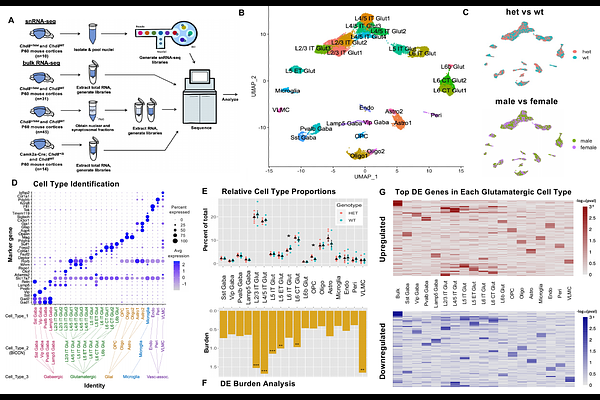Persistent cortical excitatory neuron dysregulation in adult Chd8 haploinsufficient mice.

Persistent cortical excitatory neuron dysregulation in adult Chd8 haploinsufficient mice.
Canales, C. P.; Lozano, S.; Frost, N. A.; Cichewicz, K.; Amaral, W.; Seban, N.; Fenton, E.; Wade, A.; Chu, N.; Smith, E.; Ardekani, C.; Frank, S.; Bennett, J.; Lavenex, P.; Kopley-Smith, A.; Rahbarian, D.; Corea, M.; Perla, D.; Davis, L.; Zhu, J.; Ortiz, R.; Beauregard, P.; Moyer, C.; Baker, J.; Sun, J.; Ma, B.; Lu, J.; Sohal, V. S.; Amaral, D. G.; Zuo, Y.; Nord, A. S.
AbstractCHD8 mutations cause autism spectrum disorder, cognitive deficits, and macrocephaly. Chd8+/- mouse models exhibit macrocephaly and transcriptional pathology, with inconsistent findings regarding neurogenesis, neuron function, and behavior. Via stereology and single nuclei transcriptomics (snRNA-seq), we found increased Chd8+/- cortical volume was not explained by increase in neuron number. Differential expression (DE) was present across cortical cell types, with excitatory neurons exhibiting high DE burden and shared and subclass-specific DE signatures. Bulk RNA-seq DE of constitutive Chd8+/- and conditional Camk2a-Cre Chd8+/- mice identified shared transcriptional pathology. DE in synaptosomal versus nuclear mRNA identified overlapping DEGs, but also significant differences and exaggerated synaptosomal changes. Building on DE findings implicating glutamatergic neurons, we found Chd8+/- mice exhibited altered excitatory neuron spine density and dynamics, decreased GCaMP activity correlation, and sleep perturbation. Thus, Chd8 haploinsufficiency causes lasting excitatory neuron dysfunction, perturbs RNA regulation beyond transcription, and impacts neuronal properties, cortical microcircuits, and behavior.